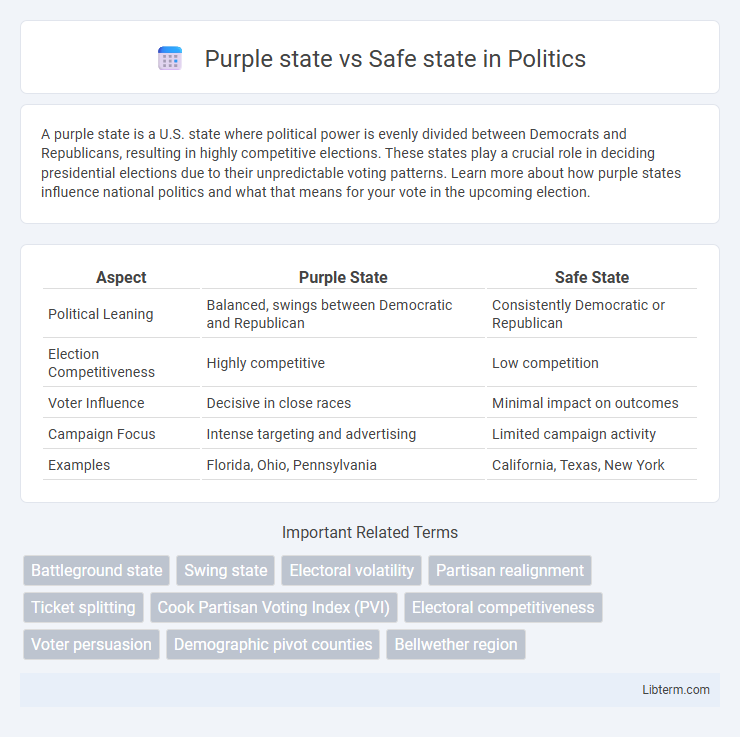A purple state is a U.S. state where political power is evenly divided between Democrats and Republicans, resulting in highly competitive elections. These states play a crucial role in deciding presidential elections due to their unpredictable voting patterns. Learn more about how purple states influence national politics and what that means for your vote in the upcoming election.
Table of Comparison
| Aspect | Purple State | Safe State |
|---|---|---|
| Political Leaning | Balanced, swings between Democratic and Republican | Consistently Democratic or Republican |
| Election Competitiveness | Highly competitive | Low competition |
| Voter Influence | Decisive in close races | Minimal impact on outcomes |
| Campaign Focus | Intense targeting and advertising | Limited campaign activity |
| Examples | Florida, Ohio, Pennsylvania | California, Texas, New York |
Understanding Purple States: Definition and Significance
Purple states, also known as battleground or swing states, exhibit a nearly equal split in voter support between Democratic and Republican parties, making them critical in U.S. elections. Their significance lies in the ability to determine the outcome of presidential races, as candidates often concentrate campaign resources and messaging in these regions to sway undecided voters. Understanding purple states involves analyzing voter demographics, historical voting patterns, and key issues that influence electoral shifts within these politically competitive areas.
What Makes a State "Safe" Politically?
A politically "safe" state is characterized by a consistent voting pattern favoring one party, such as reliably Democratic or Republican, often determined by historical election data and voter demographics. Factors like a strong party infrastructure, high voter turnout among core supporters, and cultural or economic alignment with a party's platform contribute to political safety. Purple states, in contrast, exhibit competitive electoral races where shifting voter preferences and demographic changes foster political unpredictability.
Key Characteristics of Purple States
Purple states exhibit a balanced mix of Democratic and Republican voters, making their electoral outcomes highly competitive and unpredictable. These states often have diverse populations and economic sectors, leading to a wide range of political priorities and moderate policy preferences. Their battleground status drives intense campaign efforts, significant political advertising, and increased voter turnout initiatives during elections.
Demographic Trends in Purple vs. Safe States
Purple states exhibit diverse demographic trends with higher levels of racial and ethnic diversity, younger populations, and urban growth compared to safe states, which tend to have more homogenous, older populations primarily residing in rural areas. Migration patterns show that purple states attract a mix of working-age individuals seeking economic opportunities, influencing political competitiveness and cultural shifts. Educational attainment and income diversity in purple states contribute to dynamic voting behaviors, contrasting with the more stable voting patterns observed in safe states.
Voting Patterns and Historical Shifts
Purple states exhibit fluctuating voting patterns with narrow margins between Democratic and Republican candidates, often determining the outcome of presidential elections. Safe states display consistent political alignment, with a long history of favoring either Democratic or Republican parties by large margins. Historical shifts in purple states reflect changing demographics and economic factors, influencing their swing status in contrast to the stability of safe states.
Impact on Presidential Elections
Purple states, with their balanced voter distribution between Democrats and Republicans, play a crucial role in shaping the outcome of presidential elections by often determining the electoral vote swing necessary for victory. Safe states, dominated by a single party, provide predictable electoral votes but attract less campaign attention and resources, shifting strategic focus to competitive purple states. The dynamic interplay between purple and safe states influences campaign strategies, voter turnout efforts, and overall election results in the pivotal battlegrounds.
Campaign Strategies: Purple States vs. Safe States
Campaign strategies in purple states prioritize targeted voter outreach, swing district advertising, and persuasive messaging due to their competitive nature and potential to shift election outcomes. In contrast, campaigns in safe states focus on mobilizing the base through grassroots efforts, volunteer engagement, and reinforcing party loyalty, as the electoral results are more predictable. Data-driven approaches and resource allocation vary significantly, with purple states receiving heavier investment for persuasion, while safe states emphasize turnout optimization.
The Role of Independent and Swing Voters
Independent and swing voters hold significant sway in purple states, where electoral outcomes remain highly competitive between major parties. Their fluctuating preferences can tip the balance, making these states pivotal in national elections. In contrast, safe states exhibit more predictable voting patterns, with fewer independents influencing the steady dominance of one party.
Policy Priorities in Purple and Safe States
Purple states exhibit diverse policy priorities due to their balanced political composition, often emphasizing compromise on issues like healthcare, education, and infrastructure to appeal to both conservative and liberal voters. Safe states prioritize policies that align closely with the dominant party's platform, such as strong conservative fiscal policies in Republican safe states or expansive social programs in Democratic safe states. This fundamental difference in political makeup drives the distinct policy agendas, with purple states focusing on moderate, bipartisan solutions, while safe states pursue more ideologically driven approaches.
Future Outlook: Will Purple States Multiply?
Purple states, characterized by a balanced mix of Democratic and Republican voters, may increase as demographic shifts, urbanization, and changing political attitudes reshape the electoral landscape. Trends in suburban growth, increasing diversity, and shifts in generational values contribute to the potential expansion of battleground states beyond traditional regions. Analysts predict that as these factors evolve, the number of competitive, or purple, states could grow, complicating future election strategies and outcomes.
Purple state Infographic

 libterm.com
libterm.com